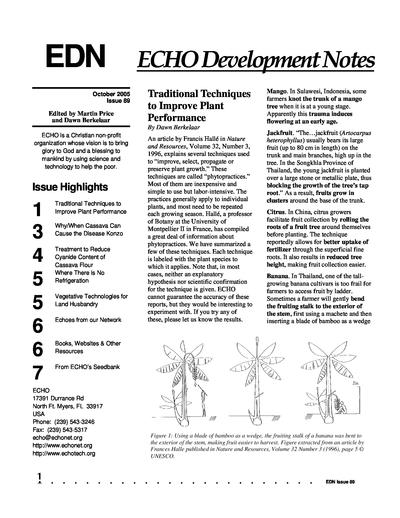
Traditional Techniques to Improve Plant Performance
Understanding Why/When Cassava Can Cause the Disease Konzo
Treatment to Reduce Cyanide Content of Cassava Flour
Where There is No Refrigeration
Vegetative and Agronomic Technologies for Land Husbandry
African Friends and Money Matters
Okra (Abelmoschus esculentus (L.) Moench): An Easy-to-Grow Multipurpose Plant
Dark Green Leafy Vegetables
Articles
Understanding Why/When Cassava Can Cause the Disease Konzo
Abstracted by Martin Price from “Food Safety and Amino Acid Balance in Processed Cassava Cossettes,” J. Agric. Food Chem. 2002, 50, 3042-3049.
Konzo is an irreversible disease that appears suddenly and causes spastic paralysis of both legs. Konzo affects mainly women and children, afflicting thousands in the remote rural areas of Bandundu Province in the Democratic Republic of Congo. It has also been reported from remote rural areas in Central African Republic, Mozambique and Tanzania. Konzo is normally brought about by a combination of exposure to cyanide and malnutrition from a low-protein diet.
Treatment to Reduce Cyanide Content of Cassava Flour
Dawn Berkelaar
In Cassava Cyanide Diseases News (CCDN), Issue 4, December 2004, Dr. J. Howard Bradbury wrote about a method of processing cassava that could substantially reduce the cyanide content of flour.
Where There is No Refrigeration
Dawn Berkelaar
Several years ago, Mohammed Bah Abba designed an earthenware cooling system (the “pot-in-pot” method) to preserve foods in countries with hot, dry climates. In Northern Nigeria (where Abba is from), no electricity is available and propane refrigeration is prohibitively expensive.
Okra (Abelmoschus esculentus (L.) Moench): An Easy-to-Grow Multipurpose Plant
Grace C. Ju
Okra provides food, feed, forage, fiber, foliage, fuel and cooking oil.
Traditional Techniques to Improve Plant Performance
Dawn Berkelaar
An article by Francis Hallé in Nature and Resources, Volume 32, Number 3, 1996, explains several techniques used to “improve, select, propagate or preserve plant growth.” These techniques are called “phytopractices.” Most of them are inexpensive and simple to use but labor-intensive. The practices generally apply to individual plants, and most need to be repeated each growing season. Hallé, a professor of Botany at the University of Montpellier II in France, has compiled a great deal of information about phytopractices. We have summarized a few of these techniques. Each technique is labeled with the plant species to which it applies. Note that, in most cases, neither an explanatory hypothesis nor scientific confirmation for the technique is given. ECHO cannot guarantee the accuracy of these reports, but they would be interesting to experiment with. If you try any of these, please let us know the results.
Vegetative and Agronomic Technologies for Land Husbandry
Dawn Berkelaar
One of the most important things a farmer can do for his farm is to prevent soil erosion. One way to do so is by keeping soil covered, especially during the rainy season. Vegetative cover and high levels of soil organic matter are key. Below is a brief description of several vegetative or agronomic technologies.
Dark Green Leafy Vegetables
Vegetative propagation of Kale and Collared Greens.